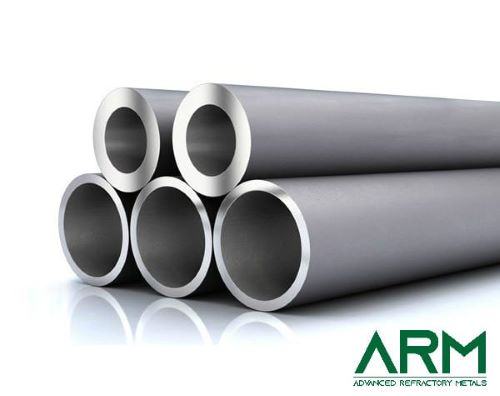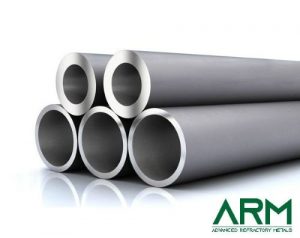Zirconium Alloys: Zr702 VS Zr705

Zr702 & Zr705
Zirconium the element (Zr, 40) is located in Group 4 and Period 5 in the periodic table. It is a silver-gray metal with impressive strength and corrosion resistance. The applications of zirconium include heat exchangers, pipe and fittings, pump and valve housings, nuclear power reactors, sputtering targets, etc.

Zirconium Tubes
There are mainly two kinds of corrosion-resistant zirconium alloys: Zr702 and Zr705, which are applied to a variety of chemical conditions.
- Zr702 is a zirconium alloy that is composed of 99.2% zirconium and 0.2% hydrogen. It is also referred to as Zircaloy-2, and it is widely used in nuclear applications as a cladding material for fuel rods. Zr702 offers excellent corrosion resistance and low neutron absorption, which makes it an ideal material for use in nuclear reactors.
- Zr705 is composed of 95.5% zirconium, 2.0% niobium, 1.5% tin, and 0.15% oxygen. It is also known as Zircaloy-4, and it is typically used in the chemical processing industry, particularly in applications where the material will be exposed to high temperatures and corrosive environments.
What Are the Similarities Between Zr702 And Zr705?
Zr702 and Zr705 share the following similarities with zirconium the metal. While they have slight differences in terms of corrosion resistance and strength, they still retain the key properties of zirconium metal.
- Low Nuclear Absorption Ability: Zirconium is used extensively in nuclear reactors. For one thing, the low neutron absorption of zirconium ensures that numerous neutrons could move freely and react easily. For another, zirconium could easily absorb electrons that escape during fission reactions, thus improving efficiency and preventing contamination.
Related reading: The Use Of Zirconium In Nuclear Reactors
- Exceptional Corrosion Resistance: Zirconium’s high affinity for oxygen leads to the formation of a protective oxide layer at room temperature, making the metal and its alloys rather resistant to acids, alkalis, and seawater. For this reason, Zr702, Zr705, and other alloys are extensively used by the chemical industry.
- Great Heat Resistance and Strength: Zirconium alloys also stand out for their great strength at high temperatures. So they are employed to make furnace linings and foundry bricks.
Related reading: Something You Should Know About Zirconium Pipes
What Are the Differences Between Zr702 And Zr705?
While Zr702 and Zr705 are both zirconium alloys with similar properties, there are also notable differences between them that affect their suitability for specific applications.
- Composition
One of the primary differences between Zr702 and Zr705 is their composition. Zr702 is composed of almost pure zirconium, with only a small amount of hydrogen added to improve its mechanical properties. On the other hand, Zr705 contains additional elements, such as niobium, tin, and oxygen, which are added to improve its high-temperature strength and formability.
- Strength
Another significant difference between these two alloys is their mechanical strength. Zr702 has excellent ductility and can be easily formed into various shapes, making it ideal for applications where a high degree of flexibility is required. In contrast, Zr705 is a stronger and more rigid material that is better suited for applications where high-temperature strength and stiffness are critical. Zr705’s tensile strength and yield strength are much higher than Zr702. You can check the table below and have a further comparison between Zr702 and Zr705.
Table 1. Mechanical Properties of Zr702 and Zr705 at Room Temperatures
| Zr702 | Zr705 | |
| Ultimate Tensile Strength, MPa (ksi) | 468.1 | 615.0 |
| Yield Strength, MPa (ksi) | 321.1 | 506.1 |
- Corrosion Resistance
As for corrosion resistance, both Zr702 and Zr705 are excellent materials. Zr702 has remarkable resistance to corrosion in nuclear reactor environments, while Zr705 is highly resistant to corrosion in harsh chemical environments. But, the corrosion-resistant properties of Zr702 are better than Zr705 in sulfuric acid.
- Cost
When it comes to cost, Zr702 is typically less expensive than Zr705 due to its simpler composition. However, the cost of these alloys can vary depending on factors such as the size and complexity of the component being produced, as well as the quantity being ordered.
Conclusion
In a word, Zr702 and Zr705 are two commonly used zirconium alloys that offer excellent corrosion resistance in harsh environments. While they share many similarities, there are significant differences in their composition, mechanical strength, and application areas. The choice between these two alloys will depend on the specific conditions of the application. Both Zr702 and Zr705 have proven to be reliable and effective materials in their respective fields, and continued research and development in zirconium alloys will likely lead to even more advanced and versatile materials in the future.
Advanced Refractory Metals (ARM) provides different kinds of zirconium alloys of different sizes and grades. Zirconium products such as pellets, powder, and wires are also available. For more information, please check our homepage.
{{item.content}}
LEVE A REPLY
{{item.children[0].content}}
{{item.content}}






